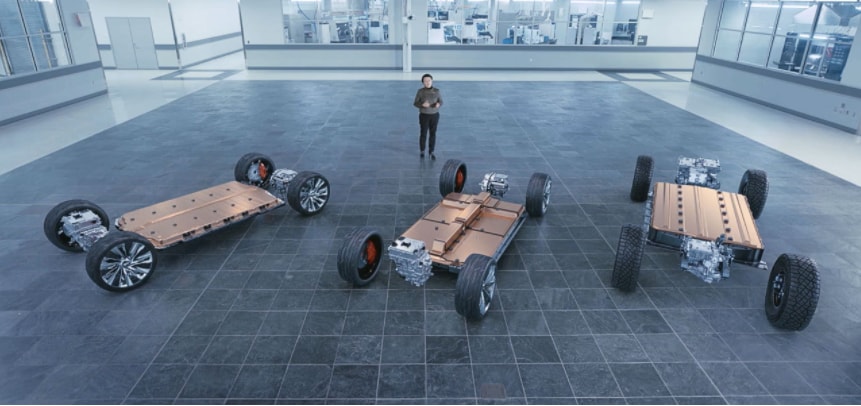Four Ways Our Flat Ultium Battery Tech is Powering Our Vision of an All-Electric Future
GM's commitment to an all-electric future has not skipped a beat, despite the global disruption of COVID-19. We've continued to innovate the pandemic at a rapid pace, already announcing an update to our Ultium battery system just eight months after its reveal. Advancements will include more energy density, lowered projected costs and increased range.
The steadfast dedication to electric vehicle development remains important because we understand that EVs are paving the way for more than just a sustainable future. Offering cutting-edge performance technology and lower maintenance costs, they're also exhilarating to drive and practical to own.
But not all EVs are created equal - it's what's on the inside that counts. Which is why we meticulously designed the Ultium battery to power out all-electric future. Sitting beneath the floor of our next generation EV's this battery module is made of flat cell pouches that can be stacked to meet the unique needs of every driver - all while improving efficiency, power and range.
Looking to learn more about what's inside an electric vehicle? Before you get behind the wheel, here are four things you need to know about our revolutionary battery technology.
Battery Design
Does shape really matter? Yes! Ultium's flat pouches waste less space and can stack on top of each other like pancakes or vertically like slices of toast. This simple modular design makes it easy for engineers to optimize energy density and vehicle layout, which translate to more miles on a single charge for less cost.
Ultium cells pack a punch! It would take 20 small cylindrical can cells (the ones our competitors use) to produce the power of one Ultium large-format 100 amp-hour cell. Our Ultium cells are so robust, they can electrically support EV's of every shape and size.
Our battery options scale from 50 kilowatt hours to our 200 kWh, which enable a GM-estimated range of over 643 km or more on a full charge.

Ultium Architecture
Eliminates significant physical constraints associated with adapting electric propulsion within a conventional vehicle architecture. Integrates the Ultium Battery System as a structural element.

Ultium Battery
Plugged in, the vehicle not only charges, but also draws electric power from the grid. This can precondition the cabin to a comfortable temperature, warm or cool the battery, and power compatible accessories - all while the vehicle is charging.

Ultium Drive
High flexible, EV propulsion system that uses five interchangeable drive units to deliver front-, rear - or all-wheel-drive vehicles from a single system across the GM lineup.
The Heart of the Ultium System
We'll engineered some of North America's most popular vehicles (think trucks, SUV's, and crossovers) with vertically-stacked cells - like toast, whereas performance vehicles, which are deeply embedded in our DNA, may include horizontally-stacked cells - like pancakes. Thanks to Ultium's flat pouch cell design, we will easily accommodate a wide range of EV's no matter what size or capability.

To save even more space, the battery's electronic components will be embedded with the modules, eliminated 80 percent of the battery pack wiring compared to today's batteries.
We reduced the height of the battery module underneath the second row, which will not only give second - row passengers a more comfortable ride, but also adds 22 kWh of energy storage in this space.

Powering Our All-Electric Future
Our Ultium battery cells feature a state-of-the-art Nickle Cobalt Manganese Aluminum (NCMA) chemistry, which was designed to reduce to cobalt in our batteries by more than 70 percent. We're continuing to push the limits of ethical sourcing of high-quality raw materials, while also reducing cost, focusing on sourcing as materials as possible from North America.
As part of our joint venture, we're working with LG Chem to combine manufacturing and electrochemical expertise to manufacture Ultium pouch cells at a new plant in Ohio, Ultium Cells LLC. Since May 2020, ground has been broken, steel construction has begun, and the site prep is on target for completion. At the facility, we will have 30 gigawatt hours of capacity and will allow in-house battery manufacturing, which will be critical to making EVs more affordable for every driver.
Future of Electrical Vehicles
Ultium packs are flexible enough to contain multiple combinations of modules to custom-tailor energy and range requirements, allowing us to deliver EV models for Buick, Cadillac, Chevrolet and GMC products.
Our battery packs can house six, eight, 10, 12 or up to 24 modules depending on what the vehicle type requires.

This ultimately allows for more freedom in the product design process. With fewer moving parts and no need to design around gas tanks, engines, radiators or exhaust pipes, our Ultium battery packs can be arranged to optimize height and length of the vehicle for aerodynamics, aesthetics, comfort, drive feel and storage.








